Last Updated: 24 June 2007
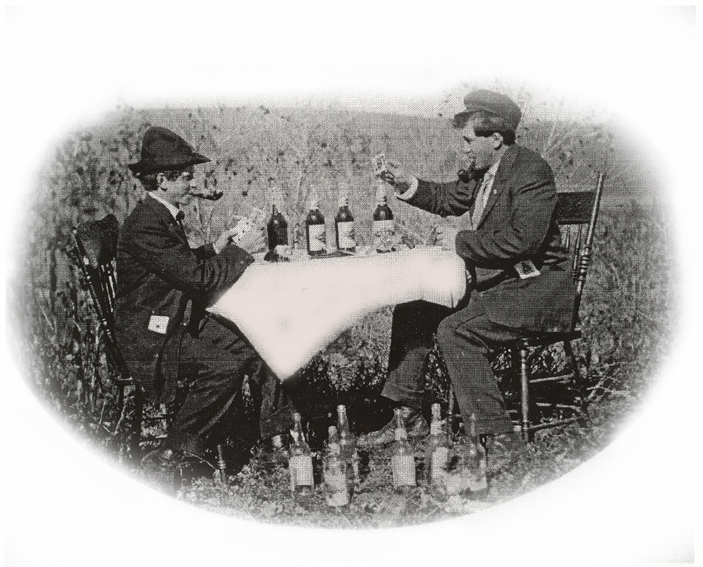
CARD GAME & A LITTLE WINE
Crimea, Russia
Early 1900s
Photograph from the photograph collection of Reinhold Schwei[c]kert (Schweigert) b. 1896 Kutchinbach / Crimea, which has two of his friends "acting silly" in their poses for the camera.
.
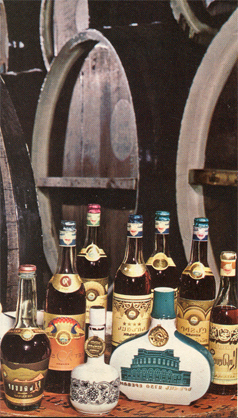
Photob Eliot Elisofon p. 162 Russian Cooking by TIME-LIFE BOOKS
LINKS
[Note: The following is mostly links that sell wine and I am not connected in any way with these companies. I am linking them only because they have information on Russian wines.]
#Moldova The Wine Country Dream Wine of the World. Talks about kinds, a little history and has photographs: http://www.moldovanwines.co.uk/Wine%20Country.htm
#Brotherhood of the Vine RUSSIA: http://www.kovr.ru/394/
#World of Russian Wines: http://www.russiawines.com/
#CRICOVA [Even in Russia]: http://www.cricova.md/eng/section/16/
>>A sparkling wine (original name "champagne") seems to be nowadays inherent to any festivity or celebration. I wonder whether there exists any other beverage characterized by such an outstanding capacity to turn the commonness in originality, excitement and splendor... But what do we know about champagne, actually?
The appearance of champagne is connected with the French province Champagne. Namely there a "traditional technology" of sparkling wines production was elaborated (Methode Champenoise), by means of the second in-bottle fermentation, with an ultimate maturation period of at least 1 year. Originally there were 3 grape varieties the champagne was made of: Pinot Meunier, Pinot Noir and Chardonnay.
The discovery of the champagne, however, is attributed to dom Pierre Perignon – a monk from the Hautvillers abbey, placed on the bank of the Marna river, in the very center of the Champagne region. He is considered to be the first who studied the process of the in-bottle fermentation and appreciated the gorgeous play of the gas bubbles penetrating the fine body of this special wine. Perignon elaborated also a well-founded system of wines' mixing from different parts of the province and of different varieties. The event looks to be even more exciting considering that many historians argue the monk to be blind. From 1688 till the end of his life (the year of 1715) he occupied the post of the chief wine-maker of the abbey.<<
>>A century ago champagne became very popular throughout the whole Europe and even in Russia. It was in great demand not only among aristocracy, but also among the "new" rich social classes. It was served everywhere: at banquets and in clubs, green-rooms and, of course, restaurants. For women (but not exclusively for them!) choosing the champagne was considered to be a sign of a good taste and style. Justly the most beautiful and elegant women of the society are often liken to this by right fashionable, flickering and exciting beverage.
The ingenious idea to produce sparkling wines in Russia belonged to grand duke A.L. Golitzin. In 1888 he invited the specialists wine-makers from France and organized a wine laboratory in his estate in Crimea, where the first experiments were made. In the year of 1899, a very favorable one for that region, his factory produced 60 thousand bottles of an exclusive, high-quality champagne. The sparkling-wine-making traditions in Crimea are still kept on. The history of the sparkling wines in Moldova began in the middle of the 20th century, when for the first time there appears the idea of founding a complex enterprise, for producing fine wines and classical sparkling wines, in strict correspondence to the traditional French technology, on the basis of the favorable local climate and soil potential. Nowadays, JSC "Cricova" is the only enterprise in Moldova, and one of four enterprises in the CIS countries, producing sparkling wines, since 1956, in exactly that way the famous monk Pierre Perignon used to do it in his Hautvillers abbey.
The classical sparkling wine is by right one of the most exquisite beverages produced by "Cricova". The technology of its production represents a long-lasting, sophisticated and delicate process. "Cricova's" sparkling wines yearly enrich Factory's collection of medals and diplomas, winning the most prestigious awards at different international fairs and wine-tastings, including those organized in France - the homeland of this marvelous beverage.<<
#Russian Drinks [includes Wine]: http://www.schools.ash.org.au/thscompst/Russia/Drink.html
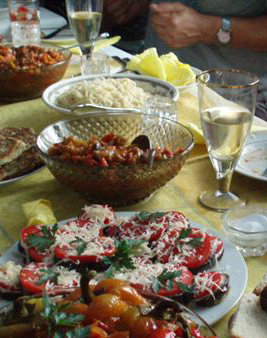
Meal in Borodino, Ukraine, (Russia)
from
From the collection of Alfred Hein
Tsar's Wines
From the peasants table to the table of Nicholas II.
Alexander Palace: >>Different sorts of wines were served at luncheons and dinners. Nicholas preferred Madeira or port with his soup. Madeira for the court came from the English firm of Krons Brothers which had supplied the court since 1888. Wines served with meat and fish dishes were more varied. White wines, such as Rudesheimer, Markobrunner, Schtrazberger and Musse came from the wine merchant Diktay on the Rhine, who supplied the court since 1884. The most preferred of the red wines were Chateau Leoville of 1881, 1887, and 1874, Chateau Lafite, Mouton Rotchilde of 1887 and Larose. As with his madeira, Nicholas never changed his affection for the French Champagne, "Monopole" from Charles Heidsieck in Rheims. Wines were served in special bottles adorned at the winery with the Imperial crest and Tsar's monogram - or in crystal carafes. The Tsar's wine cellar was exceptional and the court anticipated the rare occasions when a rare vintage was served.<<
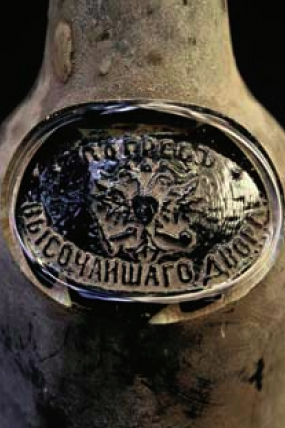
Wine bottle from Nicholas II's wine cellar which was placed into auction.
Articles on the discovery of the Tsar's wine and auction.
Telegraph.co.uk: http://www.telegraph.co.uk/news/main.jhtml?xml=/news/2004/10/09/nwine09.xml
>>
Reds from the Tsars' cellars to go under the hammer
By Will Bennett, Art Sales CorrespondentLast Updated: 1:30am BST 09/10/2004
Every year as the bitter Russian winter receded the Tsars took the imperial family to their summer palace in the Crimea where they relaxed away from the pressures of power and entertained guests on the shores of the Black Sea.
The Tsar's wine cellar was bricked up in tunnels built in the 1890s
At Livadia, their palace near Yalta, they held extravagant parties, celebrated communion in the imperial chapel and sometimes dined as a family, surrounded only by their personal servants. Wine was an integral part of their daily lives.
The Massandra winery in the Crimea was built in the 19th century to supply the needs of the Tsars' court and became legendary in Russia for its strong, sweet wines with a distinctive full flavour, utterly different from those produced in Western Europe and the New World.
Now some of the wines produced for the Tsars, many in bottles bearing the imperial seal and all of which survived both the Communist revolution and Nazi invasion, are to be auctioned at Sotheby's in London on Dec 3 when they are expected to fetch more than £500,000.
They will include five bottles of the rich, sweet Seventh Heaven, produced in 1880 by the Tsar's winemaker, Prince Lev Sergervich Golitzin, which should sell for £1,200 to £1,600 each.
The Massandra winery was built to supply the Tsars' court
Four bottles of 1893 Ai Danil red port with the Tsar's seal are expected to sell for £2,800 to £3,800 each, half a dozen bottles of Massandra-produced Madeira dating from 1913 are estimated at £4,000 to £6,000 apiece, while a single bottle of 1905 Hungarian-style wine could fetch £3,600. Massandra, now owned by the government of the Ukraine since the latter's split from Russia following the break-up of the Soviet Union, has decided to sell the wine, partly to raise the international profile of its products, which are not widely known in the West and also to get money to buy new machinery for the winery.
"Massandra is almost like a national treasure and they have got stocks of wine going right back into the 19th century but most of what they produce is drunk locally and I think they want to make people elsewhere aware of what they do," said Stephen Mould, senior director of Sotheby's wine department in London.
The Crimea was plunged into civil war after the 1917 Revolution as White Russians, aided by foreign forces, tried to turn back the Communists and the latter did not seize control of Massandra until three years later.
To protect the Tsar's wine from looters it was bricked up in tunnels built in the 1890s by an army of labourers who burrowed deep into a hillside to create some of the world's finest and coolest wine cellars.<<
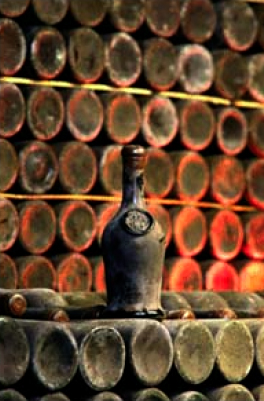
World Collectors Nite "WINES FROM THE CELLARS OF THE TSARSA, 7TH OCT 2004: Sotheby's Auction:
http://www.worldcollectorsnet.com/news/newstories/news512.html
>>ON FRIDAY December 3, 2004, Sotheby's will hold an historic sale of wines from the legendary Imperial winery at Massandra in Russia. Carefully selected from the "Massandra Collection" - the winery's own holdings of the very best wines ever produced under its aegis - the wines to be offered represent some of the finest, rarest Russian wines ever to have appeared on the market. They will include wines from the Imperial era (many of which bear the Tsar's personal seal), as well as other great vintages from the first half of the 20th century.
Massandra and its Wines
The fortified and dessert wines of Massandra are legendary, with a distinctive, full flavour that sets them apart from European and New World wines of similar ilk. More than that, the wines of Massandra occupy an important place at the heart of Russia's Imperial and cultural history. The winery (illustrated left) there was built in the late 19th century in order to supply wines for the Tsar's Summer Palace, called "Livadia", near Yalta. Over the next few decades, Massandra produced wines to cater for the Tsar's every conceivable need, from wines for Church Communion to those for the Court, for social functions and for the Tsar's own personal pleasure. The winery has continued to produce first-class wines ever since and this, combined with the extraordinary architectural merit of its cellars and other buildings, has earned it a position as one of Russia's most revered officially-designated sites of national importance.
Produced from vines that stretch almost the entire length of the South Coast of the Crimea, Massandra wines embrace a huge range of sweet wine styles, from Sherry to Madeira, from Port to Marsala, as well Tokays and Muscats. The tradition of wine-making in the Crimea goes back to the early 19th century - the result of one extraordinarily rich man's passion for wine. Reputedly richer than the Tsars themselves, Mikhail Vorontsov spared no expense in his quest to satisfy his insatiable thirst for good wine. To this end, he imported and planted innumerable types of vine from Western Europe and from these he managed to produce a number of successful wines.
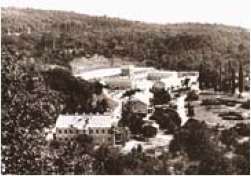
Tsar's Winery in the Crimea
In 1894, encouraged by Voronstov's success in the region, Tsar Nicholas II decided to build his own winery there. It was an enormous undertaking. Work on the cellars (illustrated right) took three years as miners dug deep into the mountainside to create a labyrinth of 21 tunnels (each over 150 metres long) that to this day rank among the finest cellars in the world. An ingenious feat of engineering (a series of carefully positioned air shafts ensures the temperature remains constantly cool, and fresh spring water creates a natural humidity of 90-95%), the cellars are also exceptionally solid and strong - when violent earthquakes caused widespread damage in the region in 1920, the cellars of Massandra were completely unscathed.
In order to ensure that his wines were the best, the Tsar employed Prince Lev Sergervich Golitzin to oversee production at the winery. An extremely accomplished winemaker, Golitzin devoted himself to developing the wines that suited the region best, and it is these same wines that define Massandra's output today. Golitzin also had an extraordinary talent for blending wines, and his "creations" are legendary. His note-keeping, however, was not so consistent, and he took the recipe for many of his greatest blends with him to the grave. To this day, no one really knows how he made his legendary "Honey of Altae Pastures" and "Seventh Heaven" wines (although, after years of experimentation, the winery feels it has finally cracked the mystery of the latter and is about to release its own recreation).
When, in 1920, Stalin's troops stormed the gates of Massandra, the future of the winery hung in the balance. But so impressed was Stalin with the wines he sampled, he decided to preserve both the winery and its historic "Collection". Under the directorship of Alexander Alexandovich, production continued and Massandra maintained its impeccable reputation for exceptional wines. The same traditions continue to this day.
The Massandra Collection
Begun by Prince Golitzin in the late 19th century, the Massandra Collection comprises examples of every Massandra vintage, as well as European wines from the personal collection of Golitzin himself. While the primary purpose of the collection was - and still is - for research purposes (i.e. to allow for study of the ageing process.), in more recent times the collection has taken on a commercial function in that it is used as a "deposit" in order to ensure that commercial quantities of mature wines are available for sale. To this end, some 10,000 bottles are added to the collection each year.
The Collection has had a remarkable history. In the years immediately following the Russian Revolution, the Crimea was plunged into political turmoil as White Russians (aided and abetted by German invaders and Anglo-French interventionists) struggled to maintain control of the area. In the midst of this, the Massandra Collection could easily have been looted, but the entrances to the tunnels in which it was stored were bricked up so skillfully that it was never discovered. When the Red Army finally took control of the area in late 1920, they discovered the collection but, rather than raid it, they added to it wines from the Tsar's palaces at Moscow, St. Petersburg and Livadia. In the following years, wine-making at Massandra continued and the collection was further augmented. In 1941, however, the charmed, tranquil life of the collection was brutally disrupted by the imminent threat of Nazi invasion. In an attempt to avoid Nazi appropriation, the entire collection was packed up and taken out of Yalta to three secret locations. It was a monumental undertaking: each bottle of wine was marked with an evacuation number and carefully crated before being transported to a safe place. The only casualty in all of this was the 1941 vintage which could not be crated out because it was still in vats at the time. Rather than surrender it to the Nazis, Aleksander Yegorov, the director of the winery, ordered that it be poured into the sea, and for the first (and possibly last) time ever, the Black Sea turned red. The collection remained hidden until 1944, when it was returned to its original resting place.
Highlights of the Sale
December's sale will include examples of some 150 different types of Massandra wine. In all, some 400 lots will be offered with a combined estimate in excess of £500,000.
For more information visit WWW.SOTHEBYS.COM
.